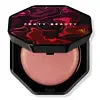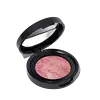Fenty Beauty Hot Cheeks Velour Blushlighter Versus Laura Geller Baked Blush-N-Brighten Marbleized Blush
What's inside
What's inside
 Key Ingredients
Key Ingredients

 Benefits
Benefits

 Concerns
Concerns

 Ingredients Side-by-side
Ingredients Side-by-side

Mica
Cosmetic ColorantSqualane
EmollientSynthetic Fluorphlogopite
C13-15 Alkane
SolventOctyldodecyl Stearoyl Stearate
EmollientDimethicone
EmollientSilica
AbrasiveOctyldodecanol
EmollientCoco-Caprylate/Caprate
EmollientPolysorbate 20
EmulsifyingLauroyl Lysine
Skin ConditioningDimethicone/Vinyl Dimethicone Crosspolymer
Skin ConditioningSorbitan Stearate
EmulsifyingMagnesium Aluminum Silicate
AbsorbentHelianthus Annuus Seed Wax
Skin ConditioningEthylhexylglycerin
Skin ConditioningTriethoxycaprylylsilane
Acrylamide/Sodium Acryloyldimethyltaurate Copolymer
Emulsion StabilisingGlyceryl Caprylate
EmollientWater
Skin ConditioningSodium Acetylated Hyaluronate
HumectantIsohexadecane
EmollientSodium Dehydroacetate
PreservativeTribehenin
EmollientTocopherol
AntioxidantMagnolia Officinalis Bark Extract
AntimicrobialTin Oxide
AbrasiveHydrogenated Ethylhexyl Olivate
EmollientPolysorbate 80
EmulsifyingJojoba Esters
EmollientSorbitan Oleate
EmulsifyingButyrospermum Parkii Butter
Skin ConditioningHydrogenated Castor Oil
EmollientKaolin
AbrasiveCI 15850
Cosmetic ColorantCI 77007
Cosmetic ColorantIron Oxides
CI 77891
Cosmetic ColorantMica, Squalane, Synthetic Fluorphlogopite, C13-15 Alkane, Octyldodecyl Stearoyl Stearate, Dimethicone, Silica, Octyldodecanol, Coco-Caprylate/Caprate, Polysorbate 20, Lauroyl Lysine, Dimethicone/Vinyl Dimethicone Crosspolymer, Sorbitan Stearate, Magnesium Aluminum Silicate, Helianthus Annuus Seed Wax, Ethylhexylglycerin, Triethoxycaprylylsilane, Acrylamide/Sodium Acryloyldimethyltaurate Copolymer, Glyceryl Caprylate, Water, Sodium Acetylated Hyaluronate, Isohexadecane, Sodium Dehydroacetate, Tribehenin, Tocopherol, Magnolia Officinalis Bark Extract, Tin Oxide, Hydrogenated Ethylhexyl Olivate, Polysorbate 80, Jojoba Esters, Sorbitan Oleate, Butyrospermum Parkii Butter, Hydrogenated Castor Oil, Kaolin, CI 15850, CI 77007, Iron Oxides, CI 77891
Mica
Cosmetic ColorantTalc
AbrasiveDimethicone
EmollientIsopropyl Palmitate
EmollientPolysorbate 20
EmulsifyingSimmondsia Chinensis Seed Oil
EmollientCentella Asiatica Extract
CleansingCamellia Sinensis Leaf Extract
AntimicrobialLauroyl Lysine
Skin ConditioningTocopheryl Acetate
AntioxidantIsohexadecane
EmollientCaprylyl Glycol
EmollientSorbitan Stearate
EmulsifyingHexylene Glycol
EmulsifyingNylon-12
Propylene Glycol Dicaprylate/Dicaprate
EmollientSorbitan Oleate
EmulsifyingAcrylamide/Sodium Acryloyldimethyltaurate Copolymer
Emulsion StabilisingMagnesium Aluminum Silicate
AbsorbentOctyldodecyl Stearate
EmollientCetearyl Ethylhexanoate
EmollientPolysorbate 80
EmulsifyingTin Oxide
AbrasiveCalcium Sodium Borosilicate
Synthetic Fluorphlogopite
Calcium Aluminum Borosilicate
Silica
AbrasivePhenoxyethanol
PreservativeSodium Dehydroacetate
PreservativeCI 77891
Cosmetic ColorantIron Oxides
CI 77007
Cosmetic ColorantCI 15850
Cosmetic ColorantCI 75470
Cosmetic ColorantMica, Talc, Dimethicone, Isopropyl Palmitate, Polysorbate 20, Simmondsia Chinensis Seed Oil, Centella Asiatica Extract, Camellia Sinensis Leaf Extract, Lauroyl Lysine, Tocopheryl Acetate, Isohexadecane, Caprylyl Glycol, Sorbitan Stearate, Hexylene Glycol, Nylon-12, Propylene Glycol Dicaprylate/Dicaprate, Sorbitan Oleate, Acrylamide/Sodium Acryloyldimethyltaurate Copolymer, Magnesium Aluminum Silicate, Octyldodecyl Stearate, Cetearyl Ethylhexanoate, Polysorbate 80, Tin Oxide, Calcium Sodium Borosilicate, Synthetic Fluorphlogopite, Calcium Aluminum Borosilicate, Silica, Phenoxyethanol, Sodium Dehydroacetate, CI 77891, Iron Oxides, CI 77007, CI 15850, CI 75470
 Reviews
Reviews

Ingredients Explained
These ingredients are found in both products.
Ingredients higher up in an ingredient list are typically present in a larger amount.
We don't have a description for Acrylamide/Sodium Acryloyldimethyltaurate Copolymer yet.
Ci 15850 is the pigment color red. It is an azo dye and created synthetically.
Azo dyes need to be thoroughly purified before use. This allows them to be more stable and longer-lasting.
This ingredient is common in foundations, lipsticks, and blushes. This color is described as brown/orangey red.
It has many secondary names such as Red 6 and Red 7. According to a manufacturer, Red 6 usually contains aluminum.
Learn more about CI 15850This pigment is called Ultramarine blue lazurite. It gives a saturated blue color, but can be used to create other colors as well.
According to the manufacturer, it is usually made from kaolin, sodium sulfate, sodium carbonate, sulfur, and charcoal.
Ci 77891 is a white pigment from Titanium dioxide. It is naturally found in minerals such as rutile and ilmenite.
It's main function is to add a white color to cosmetics. It can also be mixed with other colors to create different shades.
Ci 77891 is commonly found in sunscreens due to its ability to block UV rays.
Learn more about CI 77891Dimethicone is a type of synthetic silicone created from natural materials such as quartz.
What it does:
Dimethicone comes in different viscosities:
Depending on the viscosity, dimethicone has different properties.
Ingredients lists don't always show which type is used, so we recommend reaching out to the brand if you have questions about the viscosity.
This ingredient is unlikely to cause irritation because it does not get absorbed into skin. However, people with silicone allergies should be careful about using this ingredient.
Note: Dimethicone may contribute to pilling. This is because it is not oil or water soluble, so pilling may occur when layered with products. When mixed with heavy oils in a formula, the outcome is also quite greasy.
Learn more about DimethiconeIsohexadecane is added to enhance texture, emulsify, and to help cleanse. It is an isoparrafin. It is a component of petrolatum.
Due to its large size, Isohexadecane is not absorbed by the skin. Instead, it sits on top and acts as an emollient. Emollients help keep your skin soft and smooth by trapping moisture within.
Isohexadecane is often used in products designed to help oily skin. It is lightweight and non-greasy while helping to moisturize. When mixed with silicones, it gives a product a silky feel.
Learn more about IsohexadecaneThis ingredient comes from a fatty acid (lauric acid) and amino acid (lysine). It is used to add a silky feel to cosmetics.
According to a manufacturer, its fatty acid base leaves a silky feeling on the skin. It also has emollient properties because of this. Emollients help soften skin by preventing water from evaporating.
Lauroyl lysine is barely soluble in water.
Learn more about Lauroyl LysineMagnesium Aluminum Silicate is a type of silica. It comes from naturally occuring minerals such as silicate ores and clay.
Magnesium aluminum silicate is used for enhancing texture and as an absorbent. Due to its large molecular size, it is unable to be absorbed into the skin.
Like other types of silica, this ingredient can be used to thicken a product. As an absorbent, it may be used to absorb extra water or help prevent clumping.
Although “aluminum” in an ingredient name can raise red flags for some consumers, the form and usage context matter significantly. For typical topical applications, there is no substantial evidence of health risks - such as cancer, neurotoxicity, or systemic “aluminum overload.”
Learn more about Magnesium Aluminum SilicateMica is a naturally occurring mineral used to add shimmer and color in cosmetics. It can also help improve the texture of a product or give it an opaque, white/silver color.
Serecite is the name for very fine but ragged grains of mica.
This ingredient is often coated with metal oxides like titanium dioxide. Trace amounts of heavy metals may be found in mica, but these metals are not harmful in our personal products.
Mica has been used since prehistoric times throughout the world. Ancient Egyptian, Indian, Greek, Roman, Aztec, and Chinese civilizations have used mica.
Learn more about MicaPolysorbate 20 is made by combining ethoxylation of sorbitan, ethylene oxide, and lauric acid. It is a mild cleansing agent, surfactant, and emulsifier.
As a surfactant, it helps collect dirt and oils for washing. Emulsifiers prevent oils and water from separating.
Polysorbate 20 also adds scent to a product. Since it is made using sorbitol, it has a sweet scent. Sorbitol can also be found in fruits such as apples and peaches.
The lauric acid used to create Polysorbate 20 is often derived from coconuts.
Polysorbate 20 may not be fungal acne safe.
Learn more about Polysorbate 20Polysorbate 80 is a surfactant and emulsifier. It is used to keep ingredients together, and prevent oils and waters from separating.
It is made from polyethoxylated sorbitan and oleic acid. This ingredient can be found in cosmetics, foods, and medicine. It is water-soluble.
Polysorbate 80 may not be fungal acne safe.
Learn more about Polysorbate 80Silica, also known as silicon dioxide, is a naturally occurring mineral. It is used as a fine, spherical, and porous powder in cosmetics.
Though it has exfoliant properties, the function of silica varies depending on the product.
The unique structure of silica enhances the spreadability and adds smoothness, making it a great texture enhancer.
It is also used as an active carrier, emulsifier, and mattifier due to its ability to absorb excess oil.
In some products, tiny microneedles called spicules are made from silica or hydrolyzed sponge. When you rub them in, they lightly polish away dead skin layers and enhance the penetration of active ingredients.
Learn more about SilicaThis ingredient is a preservative with antimicrobial properties. It is the sodium salt of dehydroacetic acid.
It is especially effective at preventing bacterial and fungal growth in low concentrations.
Sorbitan Oleate is created from compounds in oleic acid and sorbitol.
It is used to stabilize a product by preventing ingredients from separating. Emulsifiers help keep ingredients together, such as oils and water.
According to a manufacturer, the ingredient Sorbitan Monooleate shares an INCI name with this one.
Sorbitan Oleate may not be fungal acne safe. It can also worsen oily skin.
Learn more about Sorbitan OleateSorbitan Stearate comes from sorbitol and stearic acid. Sorbitol is a type of sugar and stearic acid is a fatty acid.
It is used as an emulsifier and helps ingredients stay together by creating water-in-oil emulsions.
This ingredient may not be Malassezia folliculitis, or fungal-acne safe.
Synthetic Fluorphlogopite is the synthethic version of mica. It consists of fluorine, aluminum and silicate.
Synthetic Fluorphlogopite is used to add volume to products.
It is considered non-irritating on the skin.
Learn more about Synthetic FluorphlogopiteTin Oxide is an inorganic oxide used to add opacity and volume to a product. In nature, it is already found in mineral form. The main ore of tin is an opaque and shiny mineral called casseterite.
Tin Oxide helps remove translucency in a product, or make it more opaque. Besides adding opacity, tin oxide is used for bulking to add volume.
This ingredient is a combination of red, black, and yellow iron oxide pigments. This combination of colors is usually found in foundation, because it results in a "skin" color.